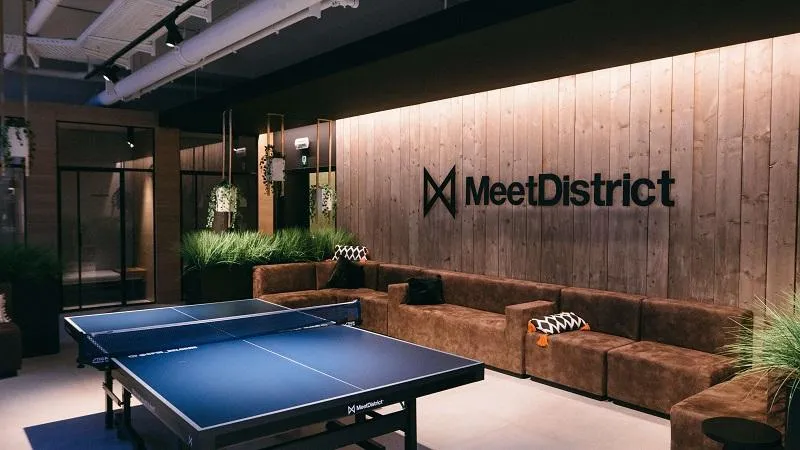Enhancing your Employee Experience

Table of Contents
What is a Company Culture?
Pretty much everybody has stumbled upon pictures that show the corporate life at companies such as Google, Youtube, Mailchimp, Facebook…
All these companies are famous for their relaxed atmosphere, their super duper cool premises, their lounges and offices, campuses and parks.
Such companies create the perfect environment for cooperation, creativity, inspiration, and growth that makes companies so popular among millenials.
Who doesn’t know the gigantic slide in the main lobby of Youtube’s headquarters or the climbing wall and bowling alley at Googleplex?
Same goes for the ultra-modern meeting rooms, and jungle-like offices at many tech firms, the casual dress code at Hubspot and other companies in the same sector, the giant meeting pencil you hold for morning stand-ups at Google, the scooters and bikes you use to go from one area to the other…
Pretty cool stuff, huh?
In companies like Asana employees are given $10K to decorate their offices the way they want so that they feel inspired and constantly creative.
Sweet!!!
But hold the phone…
How are all these elements connected to the concept of company culture?
Are bean bag chairs and funny hats actual elements of a strong corporate identity?
Do these traits and characteristics actually tell anything about company culture?
And ultimately…how do you define your company culture?
Types of Company Cultures
Perks, Benefits, and Fun
Flexible working hours, a larger than usual number of paid days of vacation, a company car, company events, vacation bonuses, dental coverage, discounts in stores, and gym subscription (to name a few) are all retention tools that large companies use to attract and hold on to great employees.
Studies showed that particularly sought-after talents are more likely to join a company and keep their position for a longer time based on their perks rather than their remuneration.
Sure, a pay raise is attractive, but the positive effect quickly fades out once people become used to the new salary.
Perks, such as benefits that increase satisfaction at work, and things that facilitate a healthy balance between social and work life have a much stronger positive effect on employee turnover.
Some companies offer cheap housing around their premises. That works well because people don’t need to commute and can spend more quality time with their families. Plus, employers can make sure that their employees aren’t forced to spend more than one third of their salary for a shelter.
Other things that work well are company daycares and nurseries to help working parents. Same goes for parental leave and flexible working hours. Anything that helps people manage their family life truly works.
At work, people are more productive if they’re satisfied with their job, their career perspectives and the general working environment.
But I’m getting already too far. I was just talking about fringe benefits.

To make things better at work, companies sometimes integrate healthy food programs at their canteen and allow people to work from home at least twice a week. This, together with yoga classes, laundry services, gym and showers seem to be highly appreciated perks.
But that’s what these are: perks. Instruments. Tools that are used to make sure that Ms. Johnson, that great engineer who solves all the problems in a few minutes, won’t go to another company that offers better conditions only a few months after being trained.
Does all this contribute to creating a company culture?
Not really.
Everything I’ve mentioned so far simply creates a positive working environment and incentives to increase motivation. It’s what we call a company package.
Companies that struggle to communicate their corporate mission (or actually lack of a relatable mission altogether) might feel compelled to offer attractive packages.
Such firms seldom manage to convincingly express how they actually improve our condition as a species on this planet. And employees have a hard time when it comes to identifying themselves with their employer.
So, how do you convince Steve in accounting to work eight hours a day without properly understanding the business model of its company and the corporate mission?
I did some coaching and consulting at a few very large companies, and I saw how insane the list of perks employees were entitled to was. Nonetheless, a lot of people I interacted with kept complaining about their job.
How so?
People quickly get used to their benefits and these are taken for granted. We’re like children who take for granted that they have a roof over their heads, running water, toys, new shoes…But where on earth are my presents?
Contrast this situation with other working environments: Peter Jackson basically didn’t pay anybody who worked on the costumes for the first Lord of The Rings movie. These people worked ten to twelve hours a day without any salary or benefits.
It’s all about purpose. The essence of the mission of a small accounting firm requires the introduction of specific tools to convince people to spend their time there. Being part of a team that creates a blockbuster movie, sends people to another planet, or manufactures ultra-modern electric cars is just plain awesome.
Perks and working conditions don’t lead to happiness, though. A great company culture does.
So let’s talk about what a great company culture is, and why it’s the only thing that actually counts.
Superficial Company Culture
Perks don’t create a company culture. Perks are tools. But what about having cool premises, a company dog, funky furniture and disco lights, a crazy company dress code, and morning rituals that bring the team together?
That’s company culture, right?
These are gimmicks. Vapor-culture. Superficial elements that create a sense of belonging.
Companies often use these as branding tools to differentiate their business, be talked about, and to convince people that they partake in something special or are part of a unique group of people who have something in common: white t-shirts, bamboo furniture, or a meeting room in a sandbox. And no… nothing I’ve mentioned so far is made up. I actually did some consulting at a company where the meeting room was a gigantic sand pit with buckets and spades!
Some companies try to retain staff with gizmos and doodads, and convince their employees that they’re lucky to be part of an elite of people who can make monkey sounds during meetings when they agree, work in isolated pods with relaxing music, and eat grapes taken directly from the vine that grows on their terraces. Would you really want to abandon such an awesome working environment? And again…I wish I made some of this stuff up.

Introducing rituals and habits can be important in order to create a sense of belonging. If you think about it, even families have their special practices that create cohesion.
Funny quirks and customs are by no means bad!
As Leif Lewinski Assistant to the Executive Board and passionate advocate for company rituals at fischerAppelt points out:
“[When it comes to shaping a corporate culture,] rituals are way more powerful than you might expect. Companies such as Viessmann had their “Thank God it‘s Monday“ ritual [that proved to be] a very powerful tool aimed at creating a culture of change.
Every Monday morning, they had a (digital) town hall meeting [with the purpose of] making everything they planned [for] their transformation as transparent as possible. Hence, they [allowed] every employee to understand the […] vision and [the importance of their] contribution.”
Some of these internal spoken or unspoken rules, can create a healthy routine, bring people together, lead to higher productivity, inspire innovation…
But these traits don’t define the deep inner culture of a company.
A company is an entity shaped by the sum of the personalities of the people who work in it, with it, and for it.
A company is a free-standing living organism that floats in an ecosystem characterized by its employees, executives, partners, competitors, service providers, suppliers, fans, customers…
Every vertical or horizontal aspect of a company is a sign of its personality and true identity.
Defining Your Company Culture and Creating a great Employee Experience
And that finally leads me to defining the important elements of a true company culture.
Let’s start microscopically. From inside the weaves of the everyday life that the employees experience.
Important factors that determine a real company culture for employees include, but aren’t solely restricted to the following areas:
- Involving employees in the overall purpose, mission, strategy, and future potential of the company
- Creating measures to foster cross-functional communication
- Communicating the big picture
- Linking functions and tasks to the main objectives of the firm
- Creating metrics to visualize the impact of each single employee on corporate strategy and results
- Creating feedback loops that allow employees to be acknowledged and appraised for their efforts and achievements
- Setting clear guidelines and a positive attitude when it comes to dealing with failure
- Creating the perfect environment that promotes individual initiatives
- Approach to personal development
- Alignment of personal and company goals
- Tutorship and support
- Creating a positive working environment based on reciprocal trust
- Fast feedback loops to quickly correct wrong decision making processes
- Shame and blame or fix and reinforce?
- Freedom and recognition
- Creating team hierarchies and structure that facilitate cooperation and project management
- Fair competition and team spirit
- Agile project management and change speed
- Creating a safe environment that fosters new ideas while constructively addressing problems
- Positive attitude to change
- Reciprocal respect and positive intra-team and cross-functional communication
- Managers who lead by example
- Allowing individuals and their personalities to impact the personality of the brand
- Diversity and inclusion
- How are instructions given?
- Attitude towards mediocrity
- Decision-making and priority-setting processes
- Recruiting processes and selection criteria
These are a few examples of areas related to the actual company culture that employees experience on their daily basis.
Satisfaction at work depends on the approach the company takes on such concepts and processes.
How to Improve Your Company Culture
A great employee experience derives from being guided and having the proper support to achieve goals, which are then recognized and praised.
Key elements of a great internal company culture include:
- Purpose
- Empowerment/Responsibility
- Ownership
- Guidance
- Role Models
- Recognition
- Respect
- Passion and Compassion
- Clear instructions/goals/KPIs
- Clear understanding of how everybody is contributing to the mission and results of the firm
- Freedom (within the scope of the activities that add to the main strategy)
- Personal development and growth
- Variety
- Work/Social life balance
- Problem solving strategy
- Positivity
There always needs to be room for fun, because people learn and develop faster when they’re immersed in a positive environment.
But a company has a mission and financial goals. A company, as an entity, reports to their investors or stockholders. A company has the moral duty to deliver on their promises for the sake of its stakeholders, partners, clients, and the surrounding community.
A great company culture, is a culture that enables people to actively contribute to this moral duty.

If a company creates that specific employee experience, people will feel proud to work there as they feel they have a meaningful purpose.
A company is a boat that floats if everybody does what they’re supposed to do in the best way they can. If somebody stops rowing the boat slows down.

Once it slows down, the company struggles to reach their goals and everybody else suffers from it. A company is an organism that relies on the work of each single element that it contains.
Creating a company culture, means offering all the tools and processes that lead to successfully implementing a corporate strategy.
That’s why the people I talked to at some of the large companies I’ve consulted were still dissatisfied with their jobs despite the great perks they were offered.
Because their ideas were ignored, their achievements weren’t recognized, and they quickly learned that the least they did the smartest they seemed but soon felt useless.
The tech world is known for aggressively reacting to such an approach.
But many companies struggle to define their identity beyond a shallow ‘fun at work’ attitude connected to their superficial culture.
Ideas and Decisions that Shape Your Company Culture
If an actual corporate culture for employees is deeply linked to the processes mentioned above, companies define their identity through other decisions they make.
Such top level decisions include:
- The choice of partners, and investors.
- Company mission, positioning, and branding
- Approach to sustainability and risk
- Attitude towards competitors
- Corporate Social Responsibility
- Customer-value vs. investor-value
- Speed
- Image and reputation
- PR and communications strategy
The approach to the external world shapes the true identity of a company, its culture, set of beliefs, and its reputation.
And most importantly…a company culture is connected to how the firm acts on its values, because simply saying “we believe in sustainability, innovation, progress, equality….” and so on doesn’t mean squat. Every company advertises that.
The overall company culture is a mix of branding elements, approaches, processes, attitudes and values; not a set of perks offered to employees or innovative architectural solutions to the problem of being forced to go down to the second floor to talk to Sabrina in marketing (yes I’ve seen companies that implemented firefighter poles!)
Creating a positive climate that focuses on solutions instead of problems in which people don’t complain but are free to act and improve their situation with the support of their team and management means creating a great company culture and a positive employee experience so that nobody will never need to say “thank God it’s Friday!”
Perks are tools of staff retention.
Great meeting rooms, technology and gadgets, interesting brainstorming sessions, home office, functional premises, flexible hours and so on are tools that, if used properly, can lead to higher productivity and support a climate of communication and innovation.
But these are tools, instruments, means. They don’t represent a company culture.
Clear guidelines that present the position of a company with the concepts listed in this article are the actual starting point that defines a company culture.
Interested in knowing more about employee experience? Watch our recent webinar in which best selling EX author Gethin Nadin talks about The Power of a Great Employee Experience and its effects on company performance!

